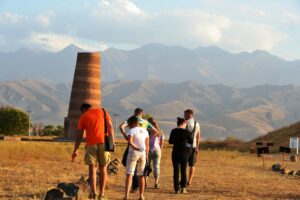Davan (Parkan) is an ancient Central Asian state that existed since the 3rd century B.C., occupying the central and eastern part of the Fergana Valley. Parkan was located on the territory of modern Kyrgyzstan. In the Chinese chronicles, the Fergana state was called Dayuan, which is translated from the ancient Turkic language as “a very beautiful, picturesque place”. The Persians called this state Sogd.
The first written mention of a strong enough state of this region is found in the Chinese sources of the III century B.C. The capital was the city of Ershi (Ura-Tube; ruins near modern Markhamat in the Aravan region). It was surrounded by rows of fortifications. The central part was surrounded by walls with towers made of mud bricks. There were up to 70 small and large towns in Parqan, scattered in separate oases. The Great Silk Road passed through Parkan. The language of the state was close to the language of the Sogdian, Parthian peoples. The population according to different data was 300,000-500,000 people. Anthropological data showed that the residents of Parkan were categorized as Caucasoid, with deep eye sockets and thick beards. The basis of the Parkan economy was irrigated agriculture, handicrafts and horse breeding. It is worth mentioning that the Fergana Valley was also influenced by such ancient states as the Achaemenid Empire and the Greco-Bactrian Kingdom, which also reflected the historical legacy of the peoples who inhabited the territory.
The Chinese Emperor Wudi, wishing to reach Ershi and get the Argamaks there, in 105 BC begins preparations for his first campaign to Daiyuan. The commander of the expedition was appointed commander Li Guangli, a relative of the emperor’s favorite. Because of poor preparation of the army and an invasion of locusts in the spring of 104, which destroyed all the grass from Shanxi to Dunhuang, causing malnutrition, fatigue and a decrease in the number of troops, the campaign was a failure.
In 102 BC Wu-di, enraged by the failure of the first campaign, undertook a second campaign to Daiyuan. The Usuns joined the alliance with China, although they did not actually take part in the campaign. On the contrary, Kangju took a hostile stance. An army of 60,000 troops was assembled, however, after many battles, a 40-day siege of Ershi and fierce resistance to the city of Yu, the Chinese were again forced to retreat with heavy losses. Still, the Davanese were forced to concede defeat and agreed to the terms of the Han. The Chinese army had lost over 50,000 men, mainly due to the negligent attitude of the commanders who profited from the supplies. Meitsai became prince of Dawan, but he was soon assassinated by the Dawan nobility, and Wugua Chanfeng was made prince. The new prince sent his son as a hostage to Han. Wu-di sent embassies to spread news of his victory in the countries of Central Asia.
Together with the horses, seedlings of Davanese grapes and alfalfa seeds came to China and were planted and used as fodder for the horses.
References to Parcana disappear around the 5th century AD.
Abdrakhmanov Yusup
Abdrakhmanov Yusup (28.12.1901 – 05.11.1938). He was born in Chirkey village, Karakol county (Issyk-Kul region).



